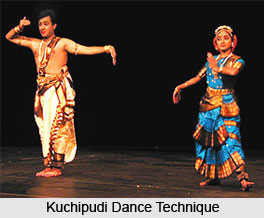 The technique of Indian Classical dance as mentioned in numerous treatises begins with Natyashastra and progress through the medieval works of 16th and 17th Centuries. Indian dance synthesizes the techniques of other arts to evolve an art which was considered the most significant of all. The principles that govern the technique of Indian classical dance are identical to those that govern the technique of Indian classical drama. Three broad principles preside over Indian drama`s structure and stage presentation. The first is the mode of presentation, namely, dharmis, Natya, loka. The second consists of the different types of styles namely Kaiseki, Sathavati, arbhati and bharati. The third is the four types of acting namely the angika, vachika, costume, make-up, stage props, and so on.
The technique of Indian Classical dance as mentioned in numerous treatises begins with Natyashastra and progress through the medieval works of 16th and 17th Centuries. Indian dance synthesizes the techniques of other arts to evolve an art which was considered the most significant of all. The principles that govern the technique of Indian classical dance are identical to those that govern the technique of Indian classical drama. Three broad principles preside over Indian drama`s structure and stage presentation. The first is the mode of presentation, namely, dharmis, Natya, loka. The second consists of the different types of styles namely Kaiseki, Sathavati, arbhati and bharati. The third is the four types of acting namely the angika, vachika, costume, make-up, stage props, and so on.
There are other principles related to these such as bahya, abhyantara, Pravrittis, samanyabhinaya and chitrabhinaya. It is the combination of all these principles which appear in their original form in the contemporary stage presentation of some of the Indian Classical Dances. Three broad principles govern the structure of Indian drama and stage presentation. The first is the mode of presentation, namely, dharmis, Natya and loka. The second consists of the different types of vrittis, namely Kaiseki, Sathavati, the arbhati and bharati. The third is full play of the four types of abhinaya, namely the angika, vachika, costume, make-up, stage props, aharya, satvika. However in Natyashastra, these principles have been discussed in the chapters on drama. The texts belonging to later period deals with dance as an independent art as well as consider these principles in relation to dance. In Abhinaya Darpana Prakasha the independent treatment of dance from the view of the principles that govern it has been enumerated. Sarangadeva and the writers of the Vishnudharmottara Purana and the Natyashastra Sangraha follow this.
The theory of Indian dance has to be comprehended as an intricate synthesis of the arts of literature, sculpture and music. There are no limitations of theme or content of the dance since it depicts the exploits of the gods, asuras and kings as well as of ordinary human beings. The Natyashastra is neither a treatise on drama alone nor a treatise on dance alone. The theory and technique of Indian classical dance has to be segregated from the entire composition.
Hence, the technique of classical Indian dancing can be classified either under nritya, Nritta and Natya or Tandava, Lasya. These terms are prevalent among practicing dancers throughout India. Though there are significant variations in interpretation the basic technique has an identical language.
Techniques of samanyabhinaya, bahya, abhyantara and chitrabhinaya are in turn composed of different elements of the four types of abhinaya. Dance technique evolved directly out of the diverse elements of the dharmis, the Vrittas, and the abhinaya. It can be concluded that drama has been utilized in the techniques of Indian classical dance.




